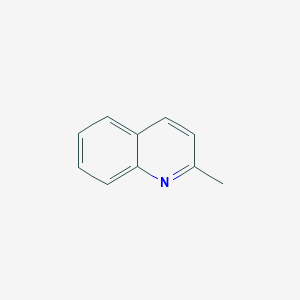| General Information of MET (ID: META00934) |
| Name |
Quinaldine
|
| Synonyms |
Click to Show/Hide Synonyms of This Metabolite
2-Methyl-quinoline; 2-Methylchinolin; 2-Methylquinoline; 2-Methylquinoline (acd/name 4.0); 2-Methylquinoline hydrochloride; 2-Methylquinoline mesylate; 2-Methylquinoline monosulfate; 2-Methylquinoline sulfate; Chinaldine; Khinaldin; Methylquinoline; Quinaldine blue; Quinaldine sulfate; Quinaldine sulfuric acid; Quinaldine sulphate; Quinaldine sulphuric acid; Quinate; Quinic acid; alpha-Methylquinoline
|
| Structure Type |
Quinolines and derivatives (Click to Show/Hide the Complete Structure Type Hierarchy)
Organoheterocyclic compounds
Quinolines and derivatives
|
| PubChem CID |
|
| HMDB ID |
|
| Formula |
C10H9N
|
| Structure |
<iframe style="width: 300px; height: 300px;" frameborder="0" src="https://embed.molview.org/v1/?mode=balls&cid=7060"></iframe>
|
 |
|
3D MOL
|
2D MOL
|
|
Click to Show/Hide the Molecular/Functional Data (External Links/Property/Function) of This Metabolite
|
| ChEBI ID |
|
| ChemSpider ID |
|
| Physicochemical Properties |
Molecular Weight |
143.18 |
Topological Polar Surface Area |
12.9 |
| XlogP |
2.6 |
Complexity |
133 |
| Heavy Atom Count |
11 |
Rotatable Bond Count |
N.A. |
| Hydrogen Bond Donor Count |
N.A. |
Hydrogen Bond Acceptor Count |
1 |
| Function |
Quinaldine or 2-methylquinoline is a simple derivative of a heterocyclic compound quinoline.
|
|
Regulatory Network
|
|
|
|
|
|
|
|
|
 click to show the details of this protein
click to show the details of this protein
 click to show the details of experiment for validating this pair
click to show the details of experiment for validating this pair

